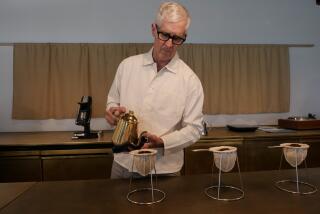AeroPress coffeemakers brew loyal fans

- Share via
As far as coffee brewing devices go, the AeroPress isn’t exactly sexy. It lacks the elegance of, say, a Japanese ceramic cone dripper or the classic Chemex glass carafe. So who would have imagined that two tubes of clear copolyester plastic fitted with a gawky black plunger could attract a cult following of coffee lovers from here to Oslo?
Since its introduction in 2006 by engineer and Stanford University lecturer Alan Adler in Palo Alto, Calif. (who also invented the Aerobie flying ring), home brewers have raved about the AeroPress on online coffee forums.
Fanatics have his-and-hers AeroPresses and won’t travel without them, not even to friends’ dinner parties. “I almost can’t drink anybody else’s coffee,” says AeroPress buff and cookbook author Janet Fletcher. Lately, even some gadget-obsessed baristas swear by it.
The AeroPress looks and works like a syringe or simple piston pump (the joke is that it resembles a male enhancement device) and has been described as a cross between a French press and a manual drip brewer. Basically, you place a cap and paper filter at the end of one tube and fill it with coffee and hot water, give the slurry a stir, then insert the plunger and press the liquid into a cup.
“Honestly, it’s one of those things that is kind of odd because coffee professionals like to see things that are glass and ceramic and … a little bit more complicated and less of a novelty,” says Ben Kaminsky, director of espresso and quality control at Ritual Coffee Roasters in San Francisco. “But the AeroPress, it just is one of the best brewing devices [for filter coffee] that you can buy.”
Other pros say that it is easy to use and makes a clean, smooth cup of coffee without any sediment in a short amount of time. (It’s also easy to clean, notes Kaminsky. “It has its own built-in squeegee, which is kind of brilliant.”)
It has caught on in cafes across Europe and at least a few in the U.S., Japan and Canada, has given rise to an AeroPress World Championship and local competitions too (it’s been a monthly event at one Caffe Fresco in Tokyo), and has spurred a secondary market of accessories — filters and stands and other accoutrements. Coava Coffee in Portland, Ore., for example, sells a reusable stainless steel AeroPress filter called the Disk.
Jeff Verellen, a barista and roaster at Caffenation in Antwerp, Belgium, is working on prototype weights in Carrara marble, iron and stone to place on top of the plunger so that you don’t have to do the work of applying your own pressure.
“The different weights will be used to time the pressing,” he says. “Depending on the grind and coffee, there are different times and pressures needed to extract the most out of each different coffee. This is also to achieve consistency in a commercial setting … and also to save time. The marble also looks nice.”
Ritual’s Kaminsky showed up in Los Angeles this month with his AeroPress in a regional competition for the first-ever Brewers Cup a manual-brew contest that will be part of the U.S. Barista Championship. He also has competed in the World AeroPress Championship — a contest started by Norwegian coffee guru Tim Wendelboe, an AeroPress proponent (who also happens to be Norway’s leading distributor).
Watching coffee drip — and making a contest of it — sounds sort of absurd, but as Kaminsky points out, “whatever brewing method wins [at the national and world Brewers Cup], you’ll see a lot of people start using it, probably at the exact same specs.”
Those specifications refer to what makes the AeroPress appealing to coffee wonks — the ones who use a refractometer and the ExtractMoJo iPhone app to measure brew strength and extraction yields. It’s easy to play with the ratio of coffee to water, grind size, water temperature and brew time, encouraging endless experimentation. (The website https://www.brewmethods.com features several AeroPress instructionals.)
“It is incredibly flexible,” says James Hoffmann, director of Square Mile Coffee Roasters in London, which hosted last year’s AeroPress Championship. “If you want to brew short, strong cups of coffee, it can do that. If you want more of a drip-style brew, it does that very well also.”
Many aficionados don’t follow the directions that come with the AeroPress (some take particular issue with the recommended coffee amount and water temperature). Adler stands by his method: “People are shocked that we’re brewing at 175 [degrees]. Use whatever temperature you like, but you owe it to yourself to at least try 175.”
Adler, who notes that the AeroPress is Aerobie Inc.’s bestselling product, says he started tinkering with the idea of a coffeemaker because he was frustrated by how difficult it was to brew a single cup of good-tasting coffee.
Among his first experiments (with a Melitta dripper) were with the temperature of the water: He landed on 175 degrees. Then he started stirring the coffee grounds and hot water together before filtering. But it still took too long to brew through, 4 or 5 minutes. “When it finally did stop dripping, there seemed to be a lot of good stuff in there, and I would press on it with the back of a soup spoon to squish that good stuff into the cup. That’s where I got the idea of pressure,” he says.
The invention has brought out the brewing hacker in coffee geeks (especially since “over-” and “under-extracting” became buzz words in barista circles). For a while, the inverted method was gaining steam among AeroPressers — turning it upside down so that liquid doesn’t start dripping through the filter right away.
Wendelboe says he prefers to use it “the traditional way”: right side up “but with a properly rinsed filter and preheated AeroPress” (rinse or run a “blind” press with hot water). “If you put the plunger on while extracting, there is very little coffee that drains from the press due to the vacuum effect it creates.”
Recipes for AeroPress coffee are mind-bogglingly varied and specific. Use 13 grams of coffee, or 20? Grind it slightly finer than filter grind, or slightly coarser? Pour water that’s at 185 degrees, or 190, or 200? Rotate the base while pouring? Cut your own paper filters so that they’re slightly oversized and cover the side holes of the filter cap? Brew — sorry, extract! — for 30 seconds, or 1 or 2 minutes?
The point is, to each his own cup of coffee — sort of. The ideal cup, if you’re measuring, has a brew strength of 1.15% to 1.5% (of total dissolved solids) and an extraction rate (of coffee flavor components) of 18% to 22%, as promoted by the Specialty Coffee Assn. of America. But how you get there is up to you.
More to Read
Eat your way across L.A.
Get our weekly Tasting Notes newsletter for reviews, news and more.
You may occasionally receive promotional content from the Los Angeles Times.











